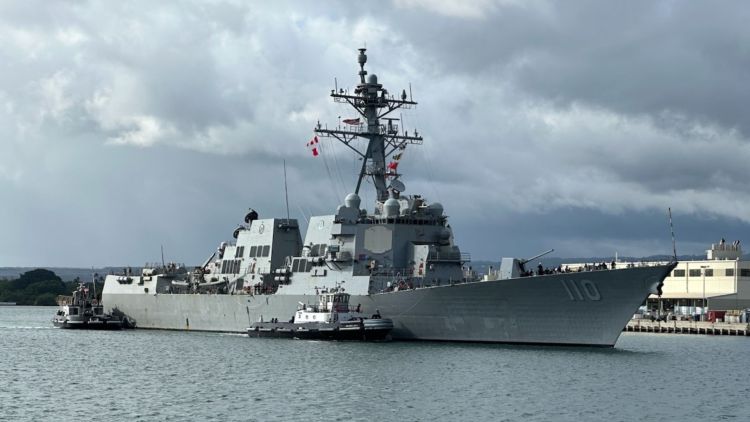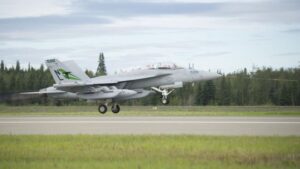The US Navy just hit an important milestone in its shipbuilding efforts with the recent keel-laying of the future USS William Charette (DDG 130), the 80th Arleigh Burke-class guided-missile destroyer, over at General Dynamics Bath Iron Works (BIW) in Maine.
But this wasn’t just about building another warship—it’s also a tribute to a brave Navy corpsman who truly embodied courage and commitment.
Kicking Off Construction: The Keel-Laying Tradition
The keel-laying ceremony on August 29 at the BIW shipyard was a big moment—it’s when all the pieces of the ship start coming together, literally.
This ceremony is a major naval tradition because it marks the “birth” of a ship.
During the event, the welder etches the initials of the honorees into the keel plate, making it official.
For the USS William Charette, Rear Adm. Darin K. Via, the Navy’s Surgeon General, did the honors on behalf of Charette’s kids, who are co-sponsoring the ship. It was a really touching tribute to Charette’s legacy.
Via spoke with pride about having a warship named after a Navy corpsman, calling it a true symbol of American strength and a testament to the courage and dedication of all Navy corpsmen.
“To have a ship named after a Navy corpsman is to hold to the maxim of ‘Corpsman Up!’ and embodies the ethos of courage, fidelity, and service before self,” said Via at the ceremony.
Honoring a Hero: The Story Behind the USS William Charette
Named after Master Chief Hospital Corpsman William “Doc” R. Charette, the USS William Charette (DDG 130) is more than just another ship in the Navy’s lineup—it’s a tribute to a true American hero.
Navy Corpsman Charette showed incredible bravery during the Korean War, serving with Company F, 2nd Battalion, 7th Marines, 1st Marine Division.
On March 27, 1953, he put his life on the line to save his fellow Marines, actions that earned him the Medal of Honor for going “above and beyond the call of duty.”
Medal of Honor recipient William R. Charette (right photo). Charette with President Dwight D. Eisenhower shortly after receiving his medal in January 1954. (Wikimedia Commons)
Naming this destroyer after him isn’t just about honoring one man’s courage; it’s about recognizing the vital role Navy corpsmen play on and off the battlefield.
A Tribute to a Navy Corpsman
Navy Corpsman Charette’s journey to becoming a legend started in Ludington, Michigan, where he was born in 1932.
After losing both parents at a young age, he was raised by his uncle and graduated high school in 1951.
He joined the Navy during the Korean War and quickly rose through the ranks, becoming a hospital corpsman. His dedication took him from the decks of a Lake Michigan ferry boat to the rugged battlefields of Korea.
Below is an excerpt from Charette’s Medal of Honor citation:
“[…] Charette stood upright in the trench line and exposed himself to a deadly hail of enemy fire in order to lend more effective aid to the victim and to alleviate his anguish while being removed to a position of safety. By his indomitable courage and inspiring efforts in behalf of his wounded comrades, HC3c. Charette was directly responsible for saving many lives. His great personal valor reflects the highest credit upon himself and enhances the finest traditions of the US Naval Service.”
Even after his heroic actions, he continued to serve with distinction, eventually becoming one of the first hospital corpsmen on a nuclear submarine, the USS Triton (SSN-586).
He spent 26 years in the Navy, training new corpsmen and serving on various ships, always ready to answer the call of duty.
Charette’s story is one of grit, resilience, and a deep commitment to service, and that’s exactly the spirit the USS William Charette will carry forward.
Ready for Anything: The Tech Behind the Charette
The USS William Charette (DDG 130) is no ordinary ship—it’s a top-of-the-line Arleigh Burke-class destroyer reportedly packed with some of the most advanced technology out there for modern warfare.
As a part of the DDG 51 Flight III class, the Charette is built to handle a wide range of threats, including those from the air, surface, and beneath the sea.
Its standout feature is the AN/SPY-6(V)1 Air and Missile Defense Radar, a cutting-edge system that allows the ship to detect and engage multiple threats at once, making it a formidable defender against both air and missile attacks.
But that’s not all. The Charette also comes with upgraded electrical systems and enhanced cooling capabilities, which means it can perform at its best even in the toughest environments.
This destroyer is designed to operate independently or as part of a larger strike group, giving it the flexibility to take on a variety of missions—whether it’s escorting convoys, engaging in anti-submarine warfare, or supporting amphibious operations.
An artist rendering of the future Arleigh Burke-class guided-missile destroyer USS William Charette. (DVIDS)
At A Glance: Tech Specifications
Displacement: 9,217 tons (full load)
Length: 510 feet (160 meters)
Beam: 66 feet (20 meters)
Propulsion: Four General Electric LM2500 gas turbines 100,000 shp (75,000 kW)
Speed: 31 knots (57 km/hour; 36 mph)
Complement: 380 officers and enlisted
Aviation Facilities: Double hangar and helipad
The USS William Charette is armed to the teeth with a powerful mix of guns, missiles, and torpedoes, ready to tackle any threat that comes its way.
It features a 5-inch Mk 45 lightweight gun, a 20 mm Phalanx CIWS for close-in defense, two 25 mm Mk 38 machine guns, and four .50-caliber guns for versatile firepower.
For missile defense, it boasts a 96-cell Mk 41 vertical launching system, equipped with a range of missiles like the RIM-66M, RIM-156, RIM-174A, RIM-161, and the quad-packed RIM-162 ESSM, covering everything from air threats to ballistic missiles.
Offensive capabilities are further enhanced by the BGM-109 Tomahawk cruise missile and RUM-139 vertical launch ASROC (Anti-Submarine Rocket) for anti-submarine warfare.
And when it comes to underwater threats, the Charette is equipped with two Mark 32 triple torpedo tubes, loaded with Mark 46, Mark 50, and Mark 54 lightweight torpedoes, ensuring it’s ready for any challenge on the high seas.
Much like its namesake, Navy Corpsman Charette, this ship is built to face any challenge head-on with courage and dedication.
Its advanced tech and versatile capabilities make it a key player in the Navy’s mission to protect US interests worldwide, ready to serve wherever and whenever it’s needed.
Next Steps: Where the USS William Charette is Headed
The keel-laying of the USS William Charette isn’t just about adding another ship to the fleet; it’s about charting the future of the US Navy.
Alongside other destroyers being built at BIW, like the Harvey C. Barnum Jr. (DDG 124), Louis H. Wilson Jr. (DDG 126), and Patrick Gallagher (DDG 127), the USS William Charette is part of the next wave of naval power.
These ships combine cutting-edge technology with tried-and-true designs to keep the Navy at the forefront of modern warfare.
The Program Executive Office (PEO) Ships, which is in charge of getting these advanced destroyers built, is key to keeping the Navy’s tech game strong.
As one of the biggest acquisition teams in the Department of Defense, PEO Ships makes sure the fleet is always ready to tackle whatever comes next.
A General Dynamic BIW welder etches the initials of the keel honorees into the keel plate during the ceremony for the future USS William Charente on August 29, 2024. (US Navy)
Final Thoughts: A Tribute to Courage
The keel-laying of the USS William Charette (DDG 130) is a big deal in the journey of this ship, soon to be one of the Navy’s most advanced warfighters.
This ceremony isn’t just about starting construction; it’s about paying tribute to the bravery of Master Chief Hospital Corpsman William Charette and all the corpsmen who’ve shown incredible courage and dedication.
As the ship takes shape, it stands as a symbol of the Navy’s strength and resilience and the spirit of everyone who’s served and sacrificed.
With every piece that gets welded on, the USS William Charette is one step closer to hitting the water, ready to protect our freedoms and carry on the mission of service.
—
Disclaimer: SOFREP utilizes AI for image generation and article research. Occasionally, it’s like handing a chimpanzee the keys to your liquor cabinet. It’s not always perfect and if a mistake is made, we own up to it full stop. In a world where information comes at us in tidal waves, it is an important tool that helps us sift through the brass for live rounds.



